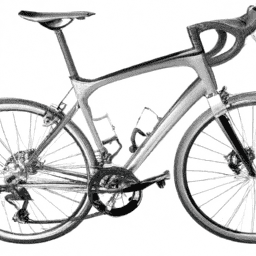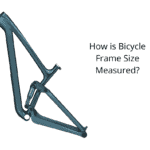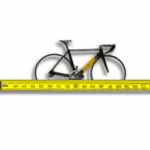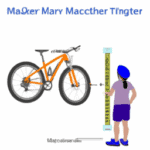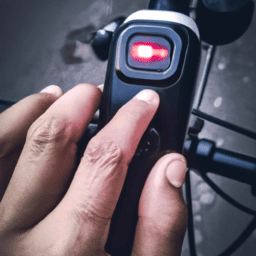For cyclists, the key to a pleasant biking experience hinges on the correct fit of their bicycle. If your bike is either too large or too small, it can cause discomfort, reduce your efficiency, and potentially result in injury. Therefore, it’s critical to be familiar with the method of sizing bicycles, allowing you to select the ideal size that matches your physique and manner of cycling.
The measurement of a bicycle’s size involves several factors, including the length of the seat tube, the top tube, and the stem. Additionally, the frame’s geometry, wheel size, and handlebar position all play a role in determining the right size for a cyclist.
In this article, we’ll explore the different methods used to measure bicycle sizes and provide tips on how to choose the best fit for your needs.
Key Takeaways
- Proper bike fit is crucial for comfort, performance, and safety.
- Body proportions, flexibility, and range of motion should be considered when choosing a bike size.
- Seat tube measurement is the most important measurement for bike fit, and measuring accuracy is crucial.
- Trying out different bike sizes and making adjustments to seat height, handlebar height, and saddle position can greatly improve comfort and find the perfect fit.
Understanding the Importance of Proper Bike Fit
You might think any bike will work for you, but understanding the importance of proper bike fit can make a significant difference in your comfort and performance. A poorly fitting bike can cause discomfort, pain, and even injury.
A bike that is too small can lead to knee pain, while a bike that is too big can cause lower back pain. Proper bike fit can also increase your efficiency, making it easier to pedal and ride longer distances.
When it comes to bike fit, there are several factors to consider. Body proportions are one of the most important. Your bike should match your body type, taking into account your height, weight, and inseam.
Flexibility and range of motion are also important. A proper bike fit should accommodate your natural range of motion, allowing you to pedal comfortably without straining your muscles. In addition to being more comfortable, a proper bike fit can also help prevent injuries and increase your overall performance on the bike.
Now, let’s move on to the seat tube measurement.
The Seat Tube Measurement
When measuring for the seat tube, it’s important to take into account the length of your inseam. This measurement determines the distance between the bottom bracket and the top of the seat tube, where the seat post fits into the frame. This is the most important measurement when it comes to bike fit, as it determines the height of the saddle and how far forward or back the saddle is positioned.
Measuring accuracy is crucial when it comes to the seat tube. If the measurement is incorrect, it can lead to discomfort and potential injury. Adjusting seat height is also important, as an incorrect height can lead to knee pain or other issues. To ensure proper fit, it’s recommended to consult with a professional bike fitter or a knowledgeable salesperson at a bike shop. Other factors to consider when choosing bike size include frame material, riding style, and intended use.
Other Factors to Consider When Choosing Bike Size
If you’re searching for the perfect fit, keep in mind that your riding style and intended use will heavily influence which bike will feel best, like a puzzle piece falling into place.
When choosing a bike size, it’s important to also consider the height of the handlebars. The handlebar height can greatly affect the comfort and performance of your ride. A higher handlebar will give you a more upright position, which can be beneficial for cruising or commuting. On the other hand, a lower handlebar will allow for a more aggressive and aerodynamic riding position, ideal for speed and performance.
Another factor to consider when choosing a bike size is the frame material. Different materials, such as aluminum, carbon fiber, and steel, can greatly affect the weight, stiffness, and overall performance of the bike.
Aluminum frames are lightweight and durable, making them a popular choice for road and mountain bikes. Carbon fiber frames are even lighter and offer superior vibration damping, but can come at a higher price point. Steel frames, on the other hand, offer a smoother ride due to their ability to absorb shock, but tend to be heavier than aluminum and carbon fiber.
When choosing a bike size, it’s important to consider all of these factors to ensure that you find the perfect fit for your needs. After all, a well-fitting bike can greatly enhance your riding experience. The next step is trying out different bike sizes to see which one feels best for your body and riding style.
Trying Out Different Bike Sizes
Imagine yourself at a local bike shop, pedaling through the aisles to get a feel for different bike options. As you try out different bike sizes, pay attention to your comfort level. A bike that fits you properly should feel comfortable, with no strain on your back, neck, or shoulders. Keep in mind that you may need to make some adjustments to the bike to achieve optimal comfort.
Here are some adjusting techniques to keep in mind as you try out different bike sizes:
-
Adjust the seat height: Make sure your feet can comfortably touch the ground when you stop, but your legs should be almost fully extended when the pedal is at the bottom of its rotation.
-
Adjust the handlebar height: The handlebars should be at a comfortable height that allows you to maintain good posture.
-
Adjust the saddle position: Move the saddle forward or backward to find the most comfortable position for your body.
-
Experiment with different frame sizes: Try out different frame sizes to see which one feels the most comfortable and allows you to ride with ease.
By following these adjusting techniques, you can find the right bike size that fits your body perfectly and allows you to enjoy your ride.
Remember, the right fit is crucial for both comfort and safety when cycling.
Frequently Asked Questions
What is the weight limit for a certain bike size?
I recently discovered that bike size weight limit is an important factor to consider when purchasing a bike. There’s a clear Size vs weight capacity comparison, with larger bikes having higher weight limits. It’s essential to choose the right size to ensure safe and comfortable riding.
Can bike sizes vary between different brands?
Bike sizes can vary between brands due to differences in frame materials and construction methods. Custom sizes offer a perfect fit but can be costly. Standard sizes are more affordable but may not fit as well.
How do I know if a bike is too small or too large for me?
When choosing a bike, finding the right size is crucial. I determine this by considering comfort vs performance, and the importance of frame geometry. A bike that is too small or too large can cause discomfort and affect performance.
Are there any special considerations for choosing a bike size for children?
When choosing a bike for children, consider pediatric sizing based on their height, inseam, and age. Keep in mind potential growth spurts and adjust accordingly. Consult a bike shop for assistance.
Can the handlebar height be adjusted to accommodate different rider heights?
Yes, handlebar height can be adjusted to accommodate different rider heights. Proper handlebar height is crucial for comfort and performance. Adjusting it involves loosening the stem bolts, adjusting the height, and tightening the bolts.
Conclusion
As a cyclist, I know firsthand the importance of proper bike fit. It can make all the difference in terms of comfort, efficiency, and overall enjoyment of riding. Just like how a shoe that’s too small can cause blisters and pain, a bike that’s not the right size can lead to a host of problems.
That’s why understanding how bike sizes are measured is crucial. One way to think of it is like a tailor making a suit. They take precise measurements to ensure the suit fits the person perfectly. Similarly, bike measurements are taken to ensure the bike fits the rider perfectly.
And just like how a poorly fitting suit can be uncomfortable and make someone feel self-conscious, a poorly fitting bike can be uncomfortable and make someone feel discouraged about riding. So, if you’re in the market for a new bike, take the time to measure yourself and try out different sizes to find the perfect fit. Your body will thank you for it.
